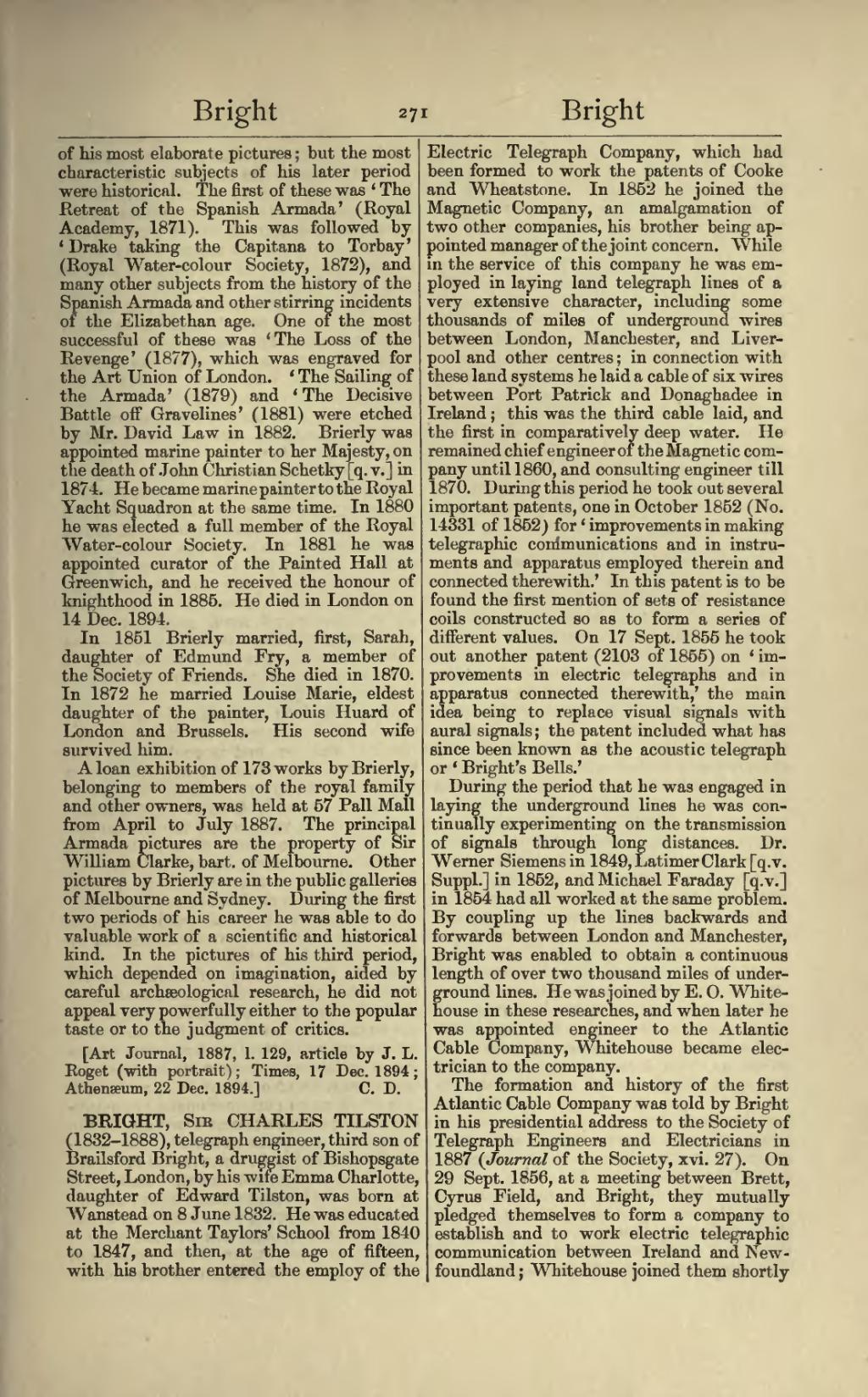of his most elaborate pictures; but the most characteristic subjects of his later period were historical. The first of these was 'The Hetreat of the Spanish Armada' (Royal Academy, 1871). This was followed by 'Drake taking the Capitana to Torbay' (Royal Water-colour Society, 1872), and many other subjects from the history of the Spanish Armada and other stirring incidents of the Elizabethan age. One of the most successful of these was 'The Loss of the Revenge' (1877), which was engraved for the Art Union of London. 'The Sailing of the Armada' (1879) and 'The Decisive Battle off Gravelines' (1881) were etched by Mr. David Law in 1882. Brierly was appointed marine painter to her Majesty, on the death of John Christian Schetky [q. v.] in 1874. He became marine painter to the Royal Yacht Squadron at the same time. In 1880 he was elected a full member of the Royal Water-colour Society. In 1881 he was appointed curator of the Painted Hall at Greenwich, and he received the honour of knighthood in 1885. He died in London on 14 Dec. 1894.
In 1851 Brierly married, first, Sarah, daughter of Edmund Fry, a member of the Society of Friends. She died in 1870. In 1872 he married Louise Marie, eldest daughter of the painter, Louis Huard of London and Brussels. His second wife survived him.
A loan exhibition of 173 works by Brierly, belonging to members of the royal family and other owners, was held at 57 Pall Mall from April to July 1887. The principal Armada pictures are the property of Sir William Clarke, bart. of Melbourne. Other pictures by Brierly are in the public galleries of Melbourne and Sydney. During the first two periods of his career he was able to do valuable work of a scientific and historical kind. In the pictures of his third period, which depended on imagination, aided by careful archaeological research, he did not appeal very powerfully either to the popular taste or to the judgment of critics.
[Art Journal, 1887, 1. 129, article by J. L. Roget (with portrait); Times, 17 Dec. 1894; Athenæum, 22 Dec. 1894.]
BRIGHT, Sir CHARLES TILSTON (1832–1888), telegraph engineer, third son of Brailsford Bright, a druggist of Bishopsgate Street, London, by his wife Emma Charlotte, daughter of Edward Tilston, was born at Wanstead on 8 June 1832. He was educated at the Merchant Taylors' School from 1840 to 1847, and then, at the age of fifteen, with his brother entered the employ of the Electric Telegraph Company, which had been formed to work the patents of Cooke and Wheatstone. In 1852 he joined the Magnetic Company, an amalgamation of two other companies, his brother being appointed manager of the joint concern. While in the service of this company he was employed in laying land telegraph lines of a very extensive character, including some thousands of miles of underground wires between London, Manchester, and Liverpool and other centres; in connection with these land systems he laid a cable of six wires between Port Patrick and Donaghadee in Ireland; this was the third cable laid, and the first in comparatively deep water. He remained chief engineer of the Magnetic company until 1860, and consulting engineer till 1870. During this period he took out several important patents, one in October 1852 (No. 14331 of 1852) for 'improvements in making telegraphic communications and in instruments and apparatus employed therein and connected therewith.' In this patent is to be found the first mention of sets of resistance coils constructed so as to form a series of different values. On 17 Sept. 1856 he took out another patent (2103 of 1855) on 'improvements in electric telegraphs and in apparatus connected therewith,' the main idea being to replace visual signals with aural signals; the patent included what has since been known as the acoustic telegraph or 'Bright's Bells.'
During the period that he was engaged in laying the underground lines he was continually experimenting on the transmission of signals through long distances. Dr. Werner Siemens in 1849, Latimer Clark [q.v. Suppl.] in 1852, and Michael Faraday [q.v.] in 1854 had all worked at the same problem. By coupling up the lines backwards and forwards between London and Manchester, Bright was enabled to obtain a continuous length of over two thousand miles of underground lines. He was joined by E. O. Whitehouse in these researches, and when later he was appointed engineer to the Atlantic Cable Company, Whitehouse became electrician to the company.
The formation and history of the first Atlantic Cable Company was told by Bright in his presidential address to the Society of Telegraph Engineers and Electricians in 1887 (Journal of the Society, xvi. 27). On 29 Sept. 1856, at a meeting between Brett, Cyrus Field, and Bright, they mutually pledged themselves to form a company to establish and to work electric telegraphic communication between Ireland and Newfoundland; Whitehouse joined them shortly
